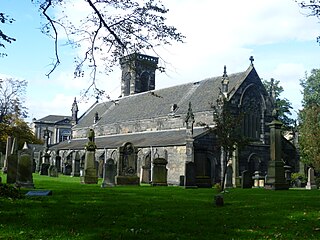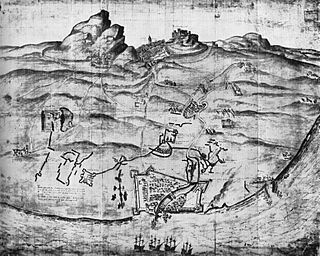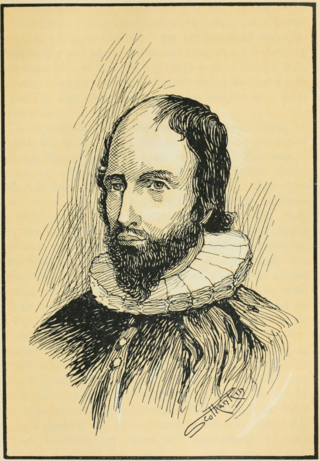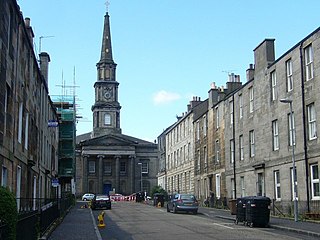
John Knox was a Scottish minister, Reformed theologian, and writer who was a leader of the country's Reformation. He was the founder of the Presbyterian Church of Scotland.

Leith is a port area in the north of Edinburgh, Scotland, founded at the mouth of the Water of Leith and is home to the Port of Leith.

Rev John Home was a Scottish minister, soldier and author. His play Douglas was a standard Scottish school text until the Second World War, but his work is now largely neglected. In 1783, he was one of the joint founders of the Royal Society of Edinburgh.

James Sharp, or Sharpe, was a minister in the Church of Scotland, or kirk, who served as Archbishop of St Andrews from 1661 to 1679. His support for Episcopalianism, or governance by bishops, brought him into conflict with elements of the kirk who advocated Presbyterianism. Twice the victim of assassination attempts, the second cost him his life.
John Willock was a Scottish reformer. He appears to have been a friar of the Franciscan House at Ayr. Having joined the party of reform before 1541, he fled for his life to England. There he became noted as a zealous and taking preacher. This led to his arrest for heresy under an Act of Henry VIII., "for abolishing diversity of opinion" in matters of religion. He was found guilty of preaching against purgatory, holy water, priestly confession, and prayer to the saints, and of holding that priests might lawfully be married, he was for some time confined in the Fleet prison. After the accession of Edward VI he was chaplain to Henry, Duke of Suffolk, who had married King Henry's niece, and is best known as the father of Lady Jane Grey. He preached for a time in London, in St Katherine's Church, when both he and John Knox, his fast friend, were granted general license to preach anywhere in England. Henry, Earl of Huntingdon, presented him to the rectory of Loughborough in Leicestershire, a living which he continued to hold during King Edward's reign, and again during that of Queen Elizabeth for the rest of his life. Thus in his later years he was in the unique position of being at the same time a parish minister in both England and Scotland. When Mary Tudor came to the English throne in 1553, Willock fled to Embden, in the Protestant Duchy of Friesland. There he practised as a physician with much success, and rose to some eminence. In 1555, and again in 1556, the Duchess Anne of Friesland sent him to Scotland as her Commissioner on matters of trade. In 1558 he returned home, and preached for some time in Dundee, with much acceptance among the friends of reform. In 1559, when John Knox had to leave Edinburgh in peril of his life, Willook took his place as the evangelist of the Reformation. It was then that he conducted in St Giles what is believed to have been the earliest public celebration of the Holy Communion in Scotland after the reformed ritual. In 1560, when Queen Mary of Guise lay dying, the Earls of Argyll and Moray, and other Lords of the Congregation advised her to "send for a godly, learned man of whom she might receive instruction"; and Willock was chosen to minister to her, which he faithfully did. That same year he was made Superintendent of Glasgow and the West. He was also one of the six Johns entrusted with the drawing up of the First Book of Discipline, the others being John Knox, John Winram, John Spottiswood, John Douglas, and John Row. Sometime in that year he went to England, and brought home his wife, Katherine Picknavell, an English lady. He was chosen Moderator of the General Assembly in 1563, 1564, 1565, and 1568. In 1565 Queen Mary endeavoured to put a stop to his activity by having him imprisoned in Dumbarton Castle; but the Reformers were now too strong for her, and she had to depart from her purpose.

Colinton is a suburb of Edinburgh, Scotland situated 3+1⁄2 miles southwest of the city centre. Up until the late 18th century it appears on maps as Collington. It is bordered by Dreghorn to the south and Craiglockhart to the north-east. To the north-west it extends to Lanark Road and to the south-west to the City Bypass. Bonaly is a subsection of the area on its southern side.

Restalrig is a small residential suburb of Edinburgh, Scotland. It is located east of the city centre, west of Craigentinny and to the east of Lochend, both of which it overlaps. Restalrig Road is the main route through the area, running from London Road, at Jock's Lodge, to Leith Links. It is in the ward of Lochend.

William Wishart (1660–1729) was a Church of Scotland minister and the Principal of Edinburgh University from 1716 to 1728. He is not to be confused with his son William Wishart (secundus), who was subsequently the Principal of Edinburgh University from 1736 to 1754.
David Lindsay (1531–1613) was one of the twelve original ministers nominated to the "chief places in Scotland" in 1560. In 1589 as one of the recognised leaders of the Kirk and as chaplain of James VI of Scotland, Lindsay accompanied James to Norway to fetch home his bride. He was appointed bishop of Ross and a privy councillor in 1600. He was five times Moderator of the General Assembly: 1577, 1582, 1586, 1593 and 1597.

South Leith Parish Church, originally the Kirk of Our Lady, St Mary, is a congregation of the Church of Scotland. It is the principal church and congregation in Leith, in Edinburgh. Its kirkyard is the burial place for John Home and John Pew, the man from whom the author Robert Louis Stevenson reputedly derived the character of Blind Pew in the novel Treasure Island. 18th-century Scottish Episcopal Church bishop and historian Robert Forbes also lies buried beneath the church floor. The church has been repaired, used as an ammunition store and reconstructed but still retains the basic layout of the nave of the old church.

The siege of Leith ended a twelve-year encampment of French troops at Leith, the port near Edinburgh, Scotland. French troops arrived in Scotland by invitation in 1548. In 1560 the French soldiers opposed Scottish supporters of religious reformation, and an English army arrived to besiege the French garrison at Leith. The town was not taken by force and the French troops finally left peacefully under the terms of a treaty signed by Scotland, England and France.

Leith Links is the principal open space within Leith, the docks district of Edinburgh, Scotland. This public park is divided by a road into two main areas, a western section and an eastern section, both being largely flat expanses of grass bordered by mature trees. Historically it covered a wider area extending north as far as the shoreline of the Firth of Forth. This area of grass and former sand-dunes was previously used as a golf links.

William Guthrie (1620–1665) was a Scottish Covenanter minister and author. He was the first minister of Fenwick parish church in Ayrshire, Scotland. He is known primarily for his book on assurance, The Christian's Great Interest.

North Leith Parish Church was a congregation of the Church of Scotland, within the Presbytery of Edinburgh. It served part of Leith, formerly an independent burgh and since 1920 a part of the city of Edinburgh, Scotland.
Andrew Fairfoul was the first post-Restoration Archbishop of Glasgow, from 1661 until his death in November 1663. He became Chancellor of the University of Glasgow after his consecration as Archbishop.

John Craig was a Reformer, and colleague of John Knox. Originally a Dominican, he became a Church of Scotland minister with significant extra responsibilities and played an influential part in the Scottish Reformation.

George Wishart (1599–1671) was a Scottish Episcopalian bishop and author.

Thomas Wilkie (1645-1711) was a Scottish minister who was elected Moderator of the Church of Scotland twice: once in 1701 and once in 1704. He was the minister at the Kirk of the Canongate.

John Livingstone was a Scottish minister. He was the son of William Livingstone, minister of Kilsyth, and afterwards of Lanark, said to be a descendant of the second son James, of the fourth Lord Livingston. His mother was Agnes, daughter of Alexander Livingston, portioner, Falkirk, brother of the Laird of Belstane.

David Johnstone (1734–1824) was a Church of Scotland minister who served almost 60 years as minister of North Leith Parish Church. He was Chaplain in Ordinary to King George IV in Scotland.

















